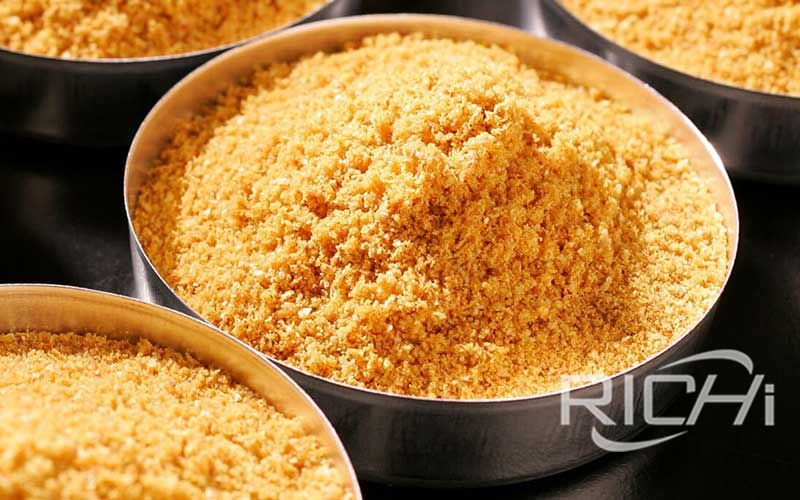
This is where you find all our press releases and news articles.
We know that cattle feed pellets are comprehensive in nutrition and good in palatability to prevent cattle from picky eating. Generally there are cattle feed pellet machine or cattle feed pellet production lines. Generally, the main ingredients are corn and soybean meal. As a cheap ingredient, can distiller's grains be used as a cheap substitute for corn and soybean meal in feed pellets? Common cattle feed ingredient tested safe for bull development.

Bull beef cattle feed pellet machine
With bull fertility to blame for a significant portion of reproductive failures in cow-calf operations, UoI researchers have explored whether distiller grain in cattle feedlot diets is safe for bull development and fertility.
Cattle feeders choose distillers grains in feedlot diets as an inexpensive alternative to corn and soybean meal. But until now, no one had studied the effects of the common feed ingredient on bull development and fertility, according to University of Illinois (UoI) researchers.
“We get questions occasionally about the effects of distillers grains on bulls, and a recent study showed some negative effects in rams. Even though there have been hundreds of experiments done on distillers grains with growing and finishing cattle, there’s very limited bull development research from a breeding standpoint,” said Daniel Shike, Associate Professor in the Department of Animal Sciences at UofI.
In the study, eight-month-old Simmental × Angus bulls consumed either a 40 percent distillers-grain diet or a standard corn-based diet for 140 days, then they all switched to a common low-energy diet for 70 days.
“We chose the 40 percent inclusion rate, which is kind of on the high end, thinking there’s really no reason to have distillers inclusion greater than that in most practical situations,” Shike said. “Then we collected data on just about everything under the sun.”
Throughout the study, the researchers measured growth performance, body condition, and hoof development, as well as a wide array of reproductive metrics. Shike and his team wanted to make the most of the opportunity to take a detailed look at bull development, citing a lack of basic information in the scientific literature.
At the end of the initial 140-day experimental treatment, only one reproductive metric differed between the groups of bulls. Those that ate distillers grains had a higher percentage of sperm with “proximal droplets,” tiny fluid-filled sacs near the head of the sperm. Normally, these droplets shake down the flagella with movement, and eventually are flung away. But when they’re retained close to the head, it is reportedly considered a major defect that could affect reproductive capacity. However, after 70 days on the low-energy diet, the problem resolved.

Distillers Grains
Similarly, the cattle that consumed distillers grains had greater body weight and fat at a couple of time points during the experiment, but, by the end of the study, the researchers could only detect a slight difference in body fat between the two groups of animals.
The fact that the two groups of bulls were essentially indistinguishable at the end of the study is said to be good news for feeders utilising distillers grains. However, Shike noted that the source of distillers grains used in the study was relatively low in sulphur; the experimental diet contained 0.23 percent sulphur as formulated, coming in below the 0.3 percent threshold for potential toxicity.
“That’s a little bit of a disclaimer. If your distillers had elevated sulphur content, I would recommend a lower inclusion than 40 percent,” he said. “Sources vary, and that’s a potential problem. It’s getting better, though. They’re getting more predictable and they’re getting lower across the board.
“The bottom line is, assuming sulphur content is not at a toxic level, we can utilise distillers in bull development rations, with very similar results as if they were developed on a corn-based diet.”
Having the right mix of reliable, high-quality pellet machine and pelletizing systems and expert support is essential to your success. Watch how our end-to-end feed pellet plant solutions have helped our customers optimize their performance.
Our customized and future-proofed turnkey pellet plant solutions is designed with you at the core. From vision to reality and beyond, our team stays connected with yours. Giving you peace-of-mind with an expert at your side.

At RICHI, we go beyond project completion. With RICHI Servicee, we’re your dedicated partners in success. Count on us for expert guidance, minimal downtime, and optimized productivity. Choose RICHI for unmatched service and support.



Meet global product demands and quality standards with industry-leading pellet plant design, engineering, equipment, and construction services for pellet processors.


Your Partner Beyond Project Completion
2000+ cases
RICHI is the leading designer, manufacturer and builder of pellet plants in the world, completing over 2000 projects in 140 countries across 6 continents.
Read More
Increase plant productivity, profitability, and safety by integrating high quality equipment into your pellet production line. Over the years, RICHI has become China's top pellet equipment manufacturer. At the same time, RICHI has established valuable partnerships with the world's leading component and raw material manufacturers to bring you the best there is in technology, automation, and efficiency in pelleting plant machinery.

For nearly 30 years, RICHI has been providing best-in-class pellet plant equipment and services to clients across a variety of industries, sizes, and needs. We pride ourselves on the knowledge and skill that each team member possesses – from our technical sales team to our process design engineers. You can count on RICHI Machinery to take your operation to the next level of innovation, quality, and success.
Need help with your pellet manufacturing plant project? Contact us today.
ANIMAL FEED
BIOMASS
WOOD
ORGANIC FERTILIZER
AQUA FEED
CAT LITTER
MUNICIPAL WASTE RECYCLING
SPECIAL PELLET PRODUCTION
RICHI Machinery continues to deliver world class pellet mill equipment, pellet plant engineering and project solutions that add value to our customers in the animal feed, wood waste, agriculture waste, organic fertilizer, cat litter and special pellet products industries. Throughout the years, we RICHI Machinery have built strong brand, becoming industry-leading pellet machine manufacturer. We value integrity, promise quality, and prioritize your success.
Learn MoreWith our expert team, we precisely implement your process engineering requirements in pellet mill and pelletizing plant systems. No matter which industry you’re in – we understand your needs and deliver solutions that meet the highest standards.
At RICHI, quality comes first. Our pellet making machine and related pellet line equipment undergo rigorous quality controls to ensure they meet the highest standards. Rely on products that are durable, safe, and efficient.
With decades of experience in pellet machine and pellet production line production, we have earned a reputation as a trusted partner in various industries. Our expertise allows us to cover a wide range of applications.
Not only do we offer premium pelleting equipment, but we are also experts at designing, building, installing, and maintaining facilities from the ground up. Our expertise is within pellt plant process design, discovering the most efficient, productive, and profitable way to handle your materials in an end-to-end cycle.

Keeping in touch with us is an effective way to solve all your problems. If you have any needs or questions, please leave your contact information, then RICHI technical consultants will send design, quotation, videos to your mailbox. You can also contact us directly via WhatsApp: +86 13838389622
Copyright©2015-2024 by HENAN RICHI MACHINERY CO., LTD. All rights reserved.